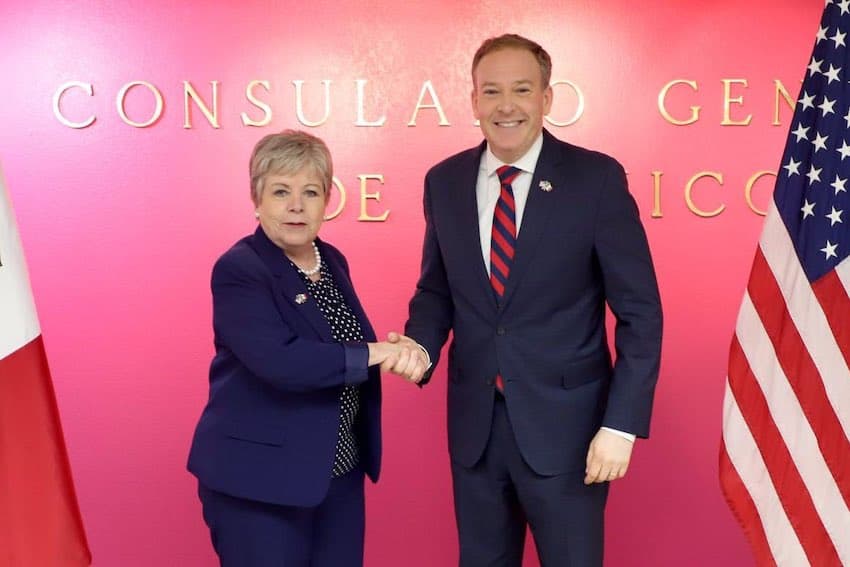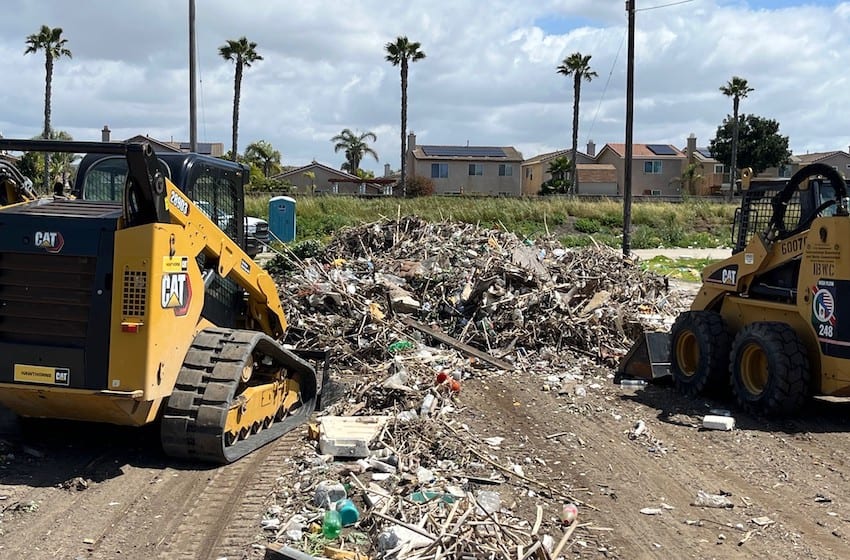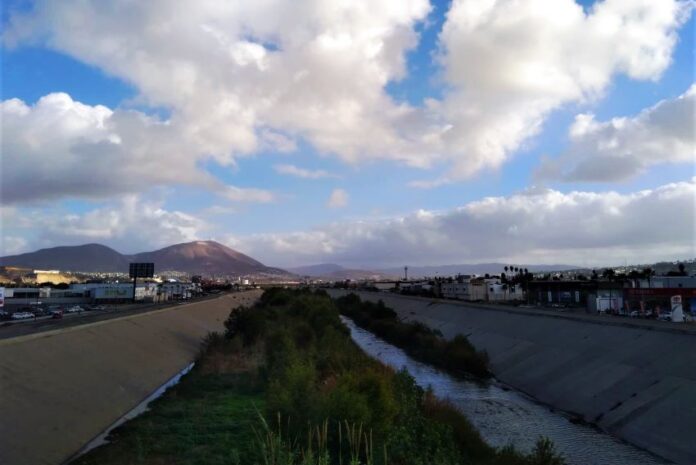The head of the United States Environmental Protection Agency (EPA) said Tuesday that Mexico must act to stop the massive flow of sewage and toxic chemicals from the Tijuana River into the Pacific Ocean off the coast of southern California, an environmental problem that has existed for decades despite the allocation of hundreds of millions of dollars to address it.
Lee Zeldin’s publicly stated demand came a day after he met with Mexico’s Environment Minister Alicia Bárcena in San Diego to discuss the contamination problem that has frequently closed beaches in southern California and sickened U.S. Navy SEALs who train in the water, among other people.
Raw sewage from Mexico has been polluting San Diego waters, land, and air for decades.
There are many facets to what specifically needs to happen next to end this crisis once and for all. These actions must be AGGRESSIVELY pursued with EXTREME urgency. pic.twitter.com/eARavdo1IF
— Lee Zeldin (@epaleezeldin) April 22, 2025
Bárcena asserted Monday that Mexico has already made an “enormous effort” to address the problem, but acknowledged there is more work to be done.
During an Earth Day visit to San Diego County, Zeldin recognized that Mexico wants to cooperate with the United States to solve the problem, but nevertheless reserved some blunt words for the Mexican government.
“Happy Earth Day. There’s nowhere more important for all of us to be than right here,” the EPA administrator said at an open-air press conference next to the Tijuana River.
“The issues that have been facing residents in this area for decades are issues of frustration, despair, disappointment, certainly motivation as well to take a crisis that has lingered for too long and finally bring it to a long overdue resolution,” said Zeldin, who on Tuesday visited San Diego County’s South Bay International Wastewater Treatment Plant, which acts as a secondary facility for the treatment of wastewater from Mexico.
The Los Angeles Times reported that the plant is in disrepair.
Accompanied by members of the U.S. Congress from both the Republican and Democratic parties, the EPA chief said that the agency he leads wants to make sure that “the path forward is one of max collaboration and extreme urgency to end a crisis that should have ended a long time ago.”
With regard to his meeting with Bárcena, Zeldin said that the environment minister spoke about the work Mexico is already doing to combat the water pollution problem and told reporters it was “clear” the Mexican government “wants to have a strong collaborative relationship” with the United States.
“She would often speak on behalf of the Mexican president about how the new Mexican president wants to have a close collaboration with the United States and the U.S. president to finally resolve this issue and I welcome that collaboration,” he said.

The EPA administrator said that Bárcena declared that Mexico is “fully committed” to doing its part to resolve the issue.
Zeldin said that “over the course of the next 24 hours,” the United States would develop a “comprehensive list of everything we believe with full confidence is going to end the crisis.”
“We don’t want the 70% solution or the 90% solution. … We all need to be on the same page on the 100% solution,” he said.
“… It’s going to be important that Mexico documents everything that they are willing to accept and follow through on that’s on our list, or not, so that we know whether or not Mexico is committed to the full list that we know will fully solve this issue,” Zeldin said.
He added that “Mexico still needs to obligate” US $88 million of $144 million it committed in 2022 to spend on addressing the Tijuana River sewage problem.
“The degradation of Tijuana River is something that people want dealt with right now,” Zeldin said.
“… Mexico needs to fulfill its part in cleaning up the contamination that they caused, [that] their people caused. They cannot view this as a U.S. problem just because their contamination reached U.S. soil. We need Mexico to not just commit to all the projects that will stop the flow [of sewage and chemicals into the Pacific Ocean] but … [also] commit to [a] final cleanup,” he said.
Zeldin didn’t say how the Trump administration would respond if Mexico failed to act in a way that definitively solved the problem.
“We’re going to … [see] whether or not Mexico is going to do its part to resolve it, and then we’ll go from there, as far as strategy and tactics,” he said.
In an interview with Fox News on Tuesday, Zeldin said Mexico needs to “finish construction to divert what is 10 million gallons [of wastewater] per day from the Tijuana River valley to the Tijuana dam.”

The list of things Mexico needs to do on its side of the border “goes on,” the EPA chief said.
In a post to X on Tuesday, Zeldin wrote:
“There is only ONE acceptable timeline to complete ALL projects on the Mexico side and U.S. side to END the crisis of raw sewage entering the U.S. from Mexico: AS FAST AS HUMANLY POSSIBLE!”
At his press conference, the EPA chief declared:
“There’s no way that we are going to stand before the people of California and ask them to have more patience and just bear with all of us as we go through the next 10 or 20 or 30 years of being stuck in 12 feet of raw sewage and not getting anywhere.”
Why is the Tijuana River so polluted?
The Associated Press reported on Tuesday that “more than 100 billion gallons of raw sewage laden with industrial chemicals and trash” has made its way into the Tijuana River since 2018.
The culprits? Ineffective wastewater treatment plants in the border city of Tijuana, where the population and industry have grown significantly in recent decades.
“The city’s growth has far outpaced the existing sewage treatment plants, and inadequate and broken facilities spew waste into the river, polluting the water and air in Imperial Beach and other [California] communities near the border,” the Los Angeles Times reported.
The 195-kilometer-long Tijuana River crosses into southern California near the coast and runs through U.S. Navy-owned land before flowing into the Pacific Ocean.
In addition to giving acute gastrointestinal illnesses to more than 1,000 Navy SEALs in recent years, the contamination has “sickened not only swimmers, surfers and lifeguards but also schoolchildren, Border Patrol agents and others who do not even go in the water,” AP reported.
“the Naval Special Warfare Center diagnosed 1,168 cases of acute gastrointestinal illnesses (AGI) among Navy SEAL and Special Warfare Combat Crewman candidates at NAB Coronado. Of these cases, 457 (39 percent) were diagnosed within 7 days of exposure to ocean water that exceeded state limits.”
A February report released by the Department of Defense found that 1,168 Navy personnel stationed at NAB Coronado, which is situated between San Diego Bay and the Pacific Ocean, had fallen ill from polluted river water.
“Scientists say the sewage is vaporized when it foams up and enters the air people breathe,” the news agency added.
Zeldin said that some $653 million has been allocated to addressing the contamination problem in the past five years. He accused Mexico of being too slow to complete projects it has committed to carrying out.
Matthew Tejada, senior vice president of environmental health for the Natural Resources Defense Fund, a New York-based environmental NGO, told the Los Angeles Times that commitments from Zeldin and other U.S. officials to solve the problem sound good. However, he asserted that achieving them will be difficult due to budget and staffing cuts in the U.S. government.
“It will be an interesting trick for EPA to achieve exactly those sorts of outcomes while they are internally tearing down the very staff and systems they need to actually make those changes happen,” Tejada said.
What is Mexico doing to mitigate the problem?
During remarks she made at the Mexican Consulate in San Diego on Monday night, Environment Minister Bárcena described her meeting with Zeldin as “very positive.”
“I believe we were able to arrive at a mutual diagnosis [and] we have very specific mechanisms to solve these problems,” she said.
Bárcena said a lot of progress has already been made, specifically touting what she called Mexico’s “enormous effort” to stop the flow of contaminated water into the Pacific Ocean.
“Mexico has just finished the San Antonio de Los Buenos plant [in Tijuana] with an investment of approximately $38 million to treat 800 liters [of wastewater] per second, but it’s not enough,” she said.
“And for that reason, one of the commitments is that the United States also complete [the upgrade to] the [South Bay] International Water Treatment Plant, which is in San Ysidro,” Bárcena said.
An upgrade of the San Antonio de Los Buenos plant was recently completed and the facility is now operating at full capacity, which should help mitigate the cross-border contamination problem.
In a statement issued on Tuesday, the Mexican Environment Ministry (Semarnat) said that new sewer lines have also been installed in Tijuana “to prevent the discharge of raw sewage at beaches in California.”
Semarnat acknowledged that some sewer projects have not yet been completed and noted that work to rehabilitate pumping stations and the Arturo Herrera and La Morita water treatment plants is also ongoing.
According to the ministry, Bárcena told Zeldin that projects that are already underway in Mexico will be expedited with a view to completion in 2027.
Semarnat noted that the completion of the upgrade and expansion of the South Bay International Water Treatment Plant was scheduled for 2029, but said the EPA chief committed to accelerating its construction so that it is ready “before 2027.”
“Both officials [Bárcena and Zeldin] expressed the great commitment of their presidents, Claudia Sheinbaum and Donald Trump, to achieve a prompt solution [to the water contamination problem] for the benefit of residents on both sides of the border,” the ministry said.
What comes next?
In a post to X on Monday, Bárcena said she and Zeldin “agreed to reinforce our joint actions … to accelerate the projects to address the sanitation of the Tijuana River for the well-being of our communities.”
Semarnat said in its statement that Mexico and the United States had reached a number of agreements aimed at combating the flow of sewage into the Tijuana River. They include that:
- The Mexican and U.S. commissioners of the International Boundary and Water Commission (IBWC) will promptly meet to “review and accelerate compliance of minute 328,” in which the IBWC outlines a range of sanitation infrastructure projects in Tijuana and San Diego.
- A meeting of the North American Development Bank will be urgently convened to “expedite the execution of key projects for the cleaning-up of the Tijuana River basin that are financed by the bank.”
- “Mexico will give priority to the rerouting of treated water from the Arturo Herrera and La Morita plants to the Abelardo Rodríguez reservoir, avoiding its discharge into the Tijuana River.
- The United States will bring forward by two years the completion date for the expansion of the South Bay International Water Treatment Plant.
- The treatment capacity of the South Bay facility will be “temporarily” increased from 25 million gallons per day to 35 million gallons per day, even as the upgrade/expansion of the facility is taking place.
- Mexico and the United States will “maintain transparent technical and institutional collaboration, avoiding disinformation or unilateral statements, with full respect for the sovereignty of both countries.”
The EPA’s “comprehensive list” of things that need to be done to address the binational water contamination crisis had not been released by early Wednesday afternoon.
Mexico and the United States are attempting to solve the long-running Tijuana River contamination problem at a time when the U.S. is pressuring its southern neighbor to deliver the water it owes under the terms of a 1944 bilateral water treaty.
Mexico currently owes the United States about 1.5 billion cubic meters of water, and is supposed to deliver it by late October — an apparently impossible task due to widespread drought that has been particularly severe in the northern states that border the U.S.
With reports from AP and Los Angeles Times
